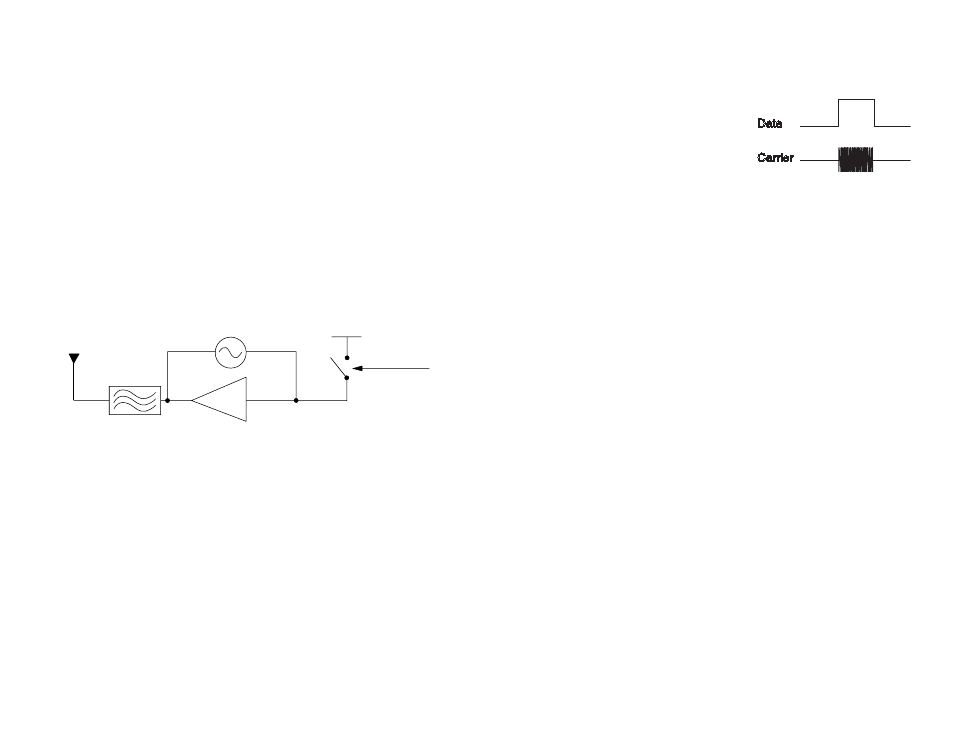Module description, Theory of operation, The data input – Linx Technologies TXM-xxx-LC User Manual
Page 7

–
–
–
–
8
9
Module Description
The LC Series transmitter is a low-cost, high-performance Surface
Acoustic Wave (SAW) based Carrier-Present Carrier-Absent (CPCA)
transmitter capable of sending serial data at up to 5,000bps. The LC’s
compact surface-mount package integrates easily into existing designs and
is equally friendly to prototype and volume production. Its ultra-low power
consumption makes it ideally suited for battery-powered products.
The transmitter’s output power varies with supply voltage, but it is capable
of outputting +10dBm into a 50-ohm load. When combined with an LR
Series receiver, a reliable serial link is formed capable of transferring data
over line-of-site distances of up to 1.5 miles (2,500m) when used with
good antennas. Legal regulations in the various countries will require the
transmitter output power to be reduced which will reduce range. Following
the legal output limit for transmitters in the United States, systems based
on the LC Series transmitter and LR Series receiver can achieve ranges of
up to 3,000 feet (1,000m).
Output Isolation
& Filter
RF Amplifier
Keyed Output
Vcc
SAW
Oscillator
Data In
300-5,000bps
50
Ω RF OUT
(ANT)
Theory of Operation
The LC Series transmitter transmits data using Carrier-Present Carrier-
Absent (CPCA) modulation. This type of AM modulation is often referred to
by other designations, including Continuous
Wave (CW) and On-Off Key (OOK). This type
of modulation represents a logic low ‘0’ by
the absence of a carrier and a logic high ‘1’
by the presence of a carrier. This method
affords numerous benefits. Three of the most
important are:
1) Cost-effectiveness due to design simplicity.
2) No minimum data rate or mark / space ratio requirement.
3) Higher output power and thus greater range in countries (such as the
U.S.) where output power measurements are averaged over time. (Please
refer to Linx Application Note AN-00130).
The LC Series transmitter is based on a simple but highly optimized
architecture that achieves a high fundamental output power with low
harmonic content. This ensures that approval requirements can be
met without external filter components. The LC Series transmitter is
exceptionally stable over time, temperature, and physical shock as a result
of the precision Surface Acoustic Wave (SAW) frequency reference. Due to
the accuracy of the SAW device, most of the output power is concentrated
in a narrow bandwidth. This allows the receiver’s bandwidth to be quite
narrow, thus increasing sensitivity and reducing susceptibility to near-band
interference. The quality of components and overall architecture utilized in
the module is extraordinary in a low-cost RF device and is one reason why
the LC Series transmitter is able to outperform more expensive products.
The Data Input
A CMOS / TTL level data input is provided on Pin 2. This line is normally
supplied with a serial bit stream input directly from a microprocessor,
encoder or UART. During standby, or the input of a logic low, the carrier is
fully suppressed and the transmitter consumes less than 2µA of current.
During a logic high, the transmitter generates a carrier to indicate to the
receiver the presence of a logic ‘1’. The applied data should not exceed a
rate of 5,000bps. The data input line should always be driven with a voltage
common to the supply voltage present on Pin 7 (V
CC
) and should never be
allowed to exceed the supply voltage.
Figure 12: LC Series Transmitter Block Diagram
Data
Carrier
Figure 13: CPCA (AM) Modulation
